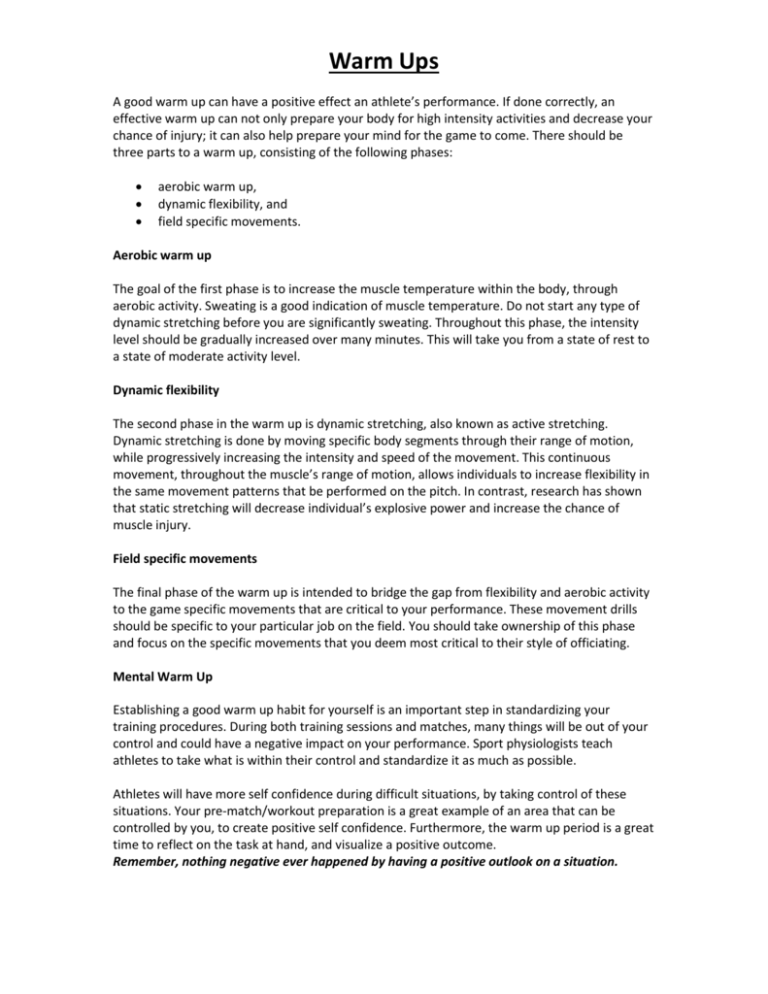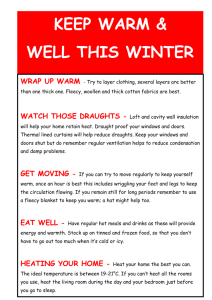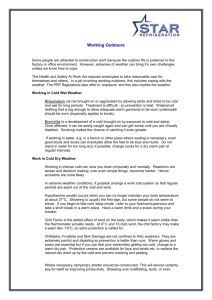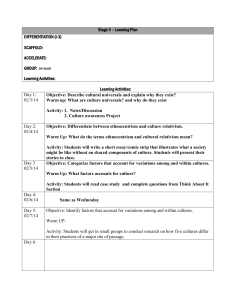Warm ups hand-out - Bankstown Football Referees
advertisement

Warm Ups A good warm up can have a positive effect an athlete’s performance. If done correctly, an effective warm up can not only prepare your body for high intensity activities and decrease your chance of injury; it can also help prepare your mind for the game to come. There should be three parts to a warm up, consisting of the following phases: aerobic warm up, dynamic flexibility, and field specific movements. Aerobic warm up The goal of the first phase is to increase the muscle temperature within the body, through aerobic activity. Sweating is a good indication of muscle temperature. Do not start any type of dynamic stretching before you are significantly sweating. Throughout this phase, the intensity level should be gradually increased over many minutes. This will take you from a state of rest to a state of moderate activity level. Dynamic flexibility The second phase in the warm up is dynamic stretching, also known as active stretching. Dynamic stretching is done by moving specific body segments through their range of motion, while progressively increasing the intensity and speed of the movement. This continuous movement, throughout the muscle’s range of motion, allows individuals to increase flexibility in the same movement patterns that be performed on the pitch. In contrast, research has shown that static stretching will decrease individual’s explosive power and increase the chance of muscle injury. Field specific movements The final phase of the warm up is intended to bridge the gap from flexibility and aerobic activity to the game specific movements that are critical to your performance. These movement drills should be specific to your particular job on the field. You should take ownership of this phase and focus on the specific movements that you deem most critical to their style of officiating. Mental Warm Up Establishing a good warm up habit for yourself is an important step in standardizing your training procedures. During both training sessions and matches, many things will be out of your control and could have a negative impact on your performance. Sport physiologists teach athletes to take what is within their control and standardize it as much as possible. Athletes will have more self confidence during difficult situations, by taking control of these situations. Your pre-match/workout preparation is a great example of an area that can be controlled by you, to create positive self confidence. Furthermore, the warm up period is a great time to reflect on the task at hand, and visualize a positive outcome. Remember, nothing negative ever happened by having a positive outlook on a situation. Warm Ups The following are some suggested sets of warm up plans, one for general use and one for both referees and assistant referees. As you begin to change your warm up procedures, you may experience some soreness and fatigue. This is a typical response to learning and performing new activities. It is suggested that starting when you have a few weeks in-between critical games would be best. Although this may feel like a workout at first, over time these exercises will get easier and eventually become intuitive. Please make sure you are performing each drill appropriately in order to prevent injuries. You are encouraged to take the philosophies established in this document and modify the procedures to best fit your personal needs. Once you have established a personal warm up of your choice, make sure to perform this warm up before every workout and match. Aerobic warm up (8 to 10min. total time CONTINUOUS) 3-5min. easy jogging on the field, building up in intensity to a vigorous jog. 50m Backward runs (Easy) + 50m Forward run (Easy) 25m Side slide right (Easy) + 25m Forward run (Easy) 50m Backward runs (Easy) + 50m Forward run (Easy) 25m Side slide left (Easy) + 25m Forward run (Easy) 25m Backward run (Moderate Pace) +25m easy jogging 25m Forward run (Moderate Pace) +25m easy jogging Dynamic stretching activities (5 to 8min. total time) Walking knee to Chest (3-5 each leg) Walking hip cradle (3-5 each leg) Forward lunge + Hamstring (3-5 each leg) Extended lateral lunge (3-5 each side) Walking leg swings (5 each leg) Dynamic Calf Stretch + Easy Ankle Skipping (a few each leg) Eagles (Hip Rotations) (5 each leg) Field specific movements (5-8 min. total time) Run 50 meters, at 65-70% maximum pace – then easy jog back Run 50 meters, at 75-80% maximum pace – then easy jog back As you work your way across the pitch, start by Jogging 4-5 steps, then plant on the outside leg and cut to change direction. Accelerate and sprint 5-7 steps at high speed (85% maximum pace) before you decelerate. Continue to repeat, while switching cutting direction, for about 50m. Run forward at a moderate pace for 15meters. Then, quickly change directions and run backwards quickly for approximately 5meters. Next, push off forward at an easy running pace. Keep repeating the drill running forwards and backwards for approximately 50m, followed by an easy jog back. Perform any additional warm up drills you feel necessary.







